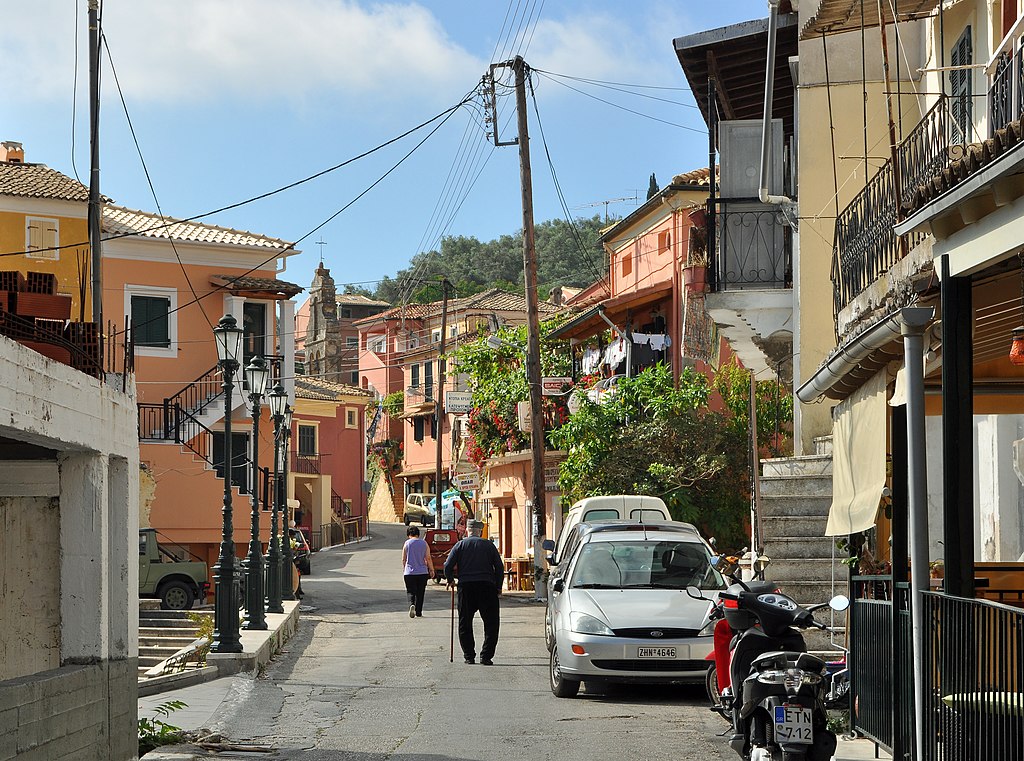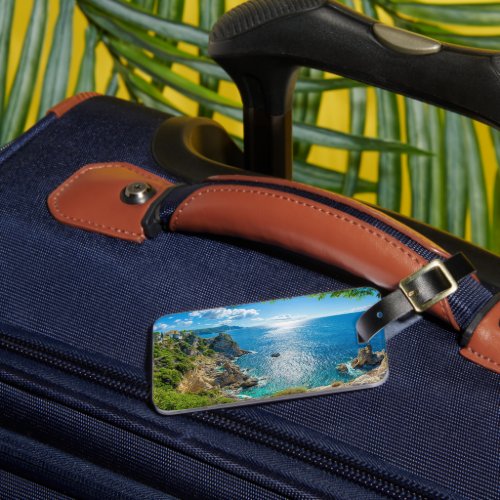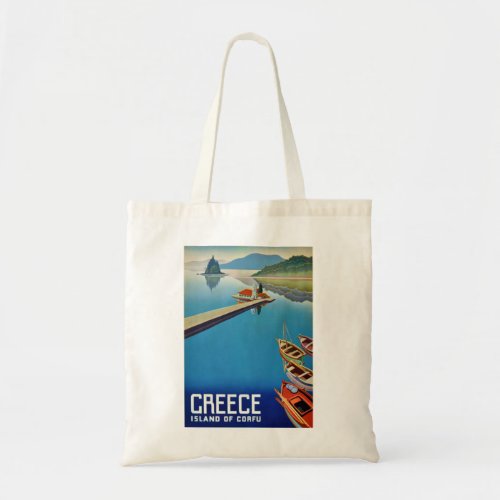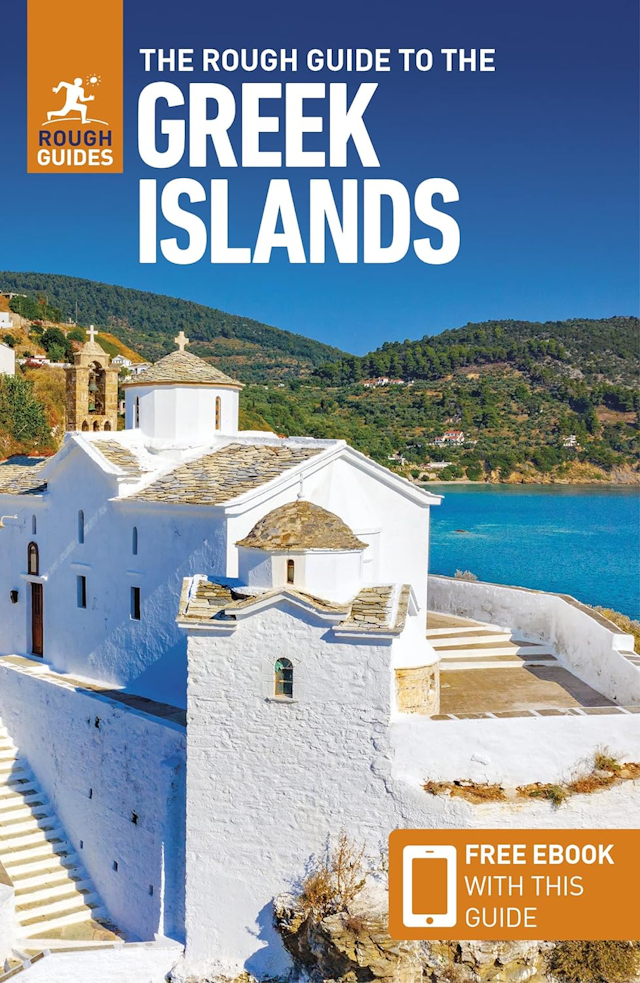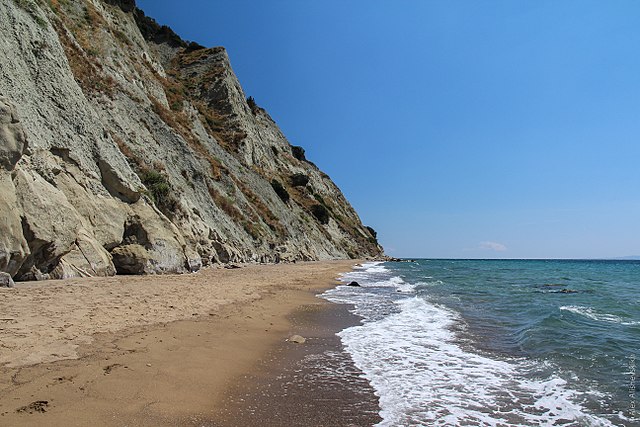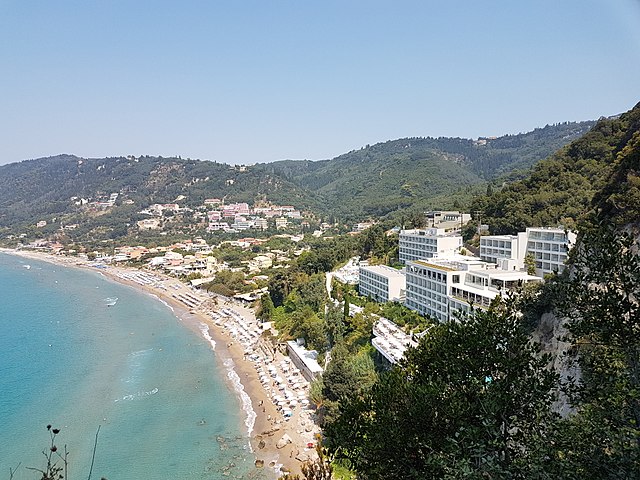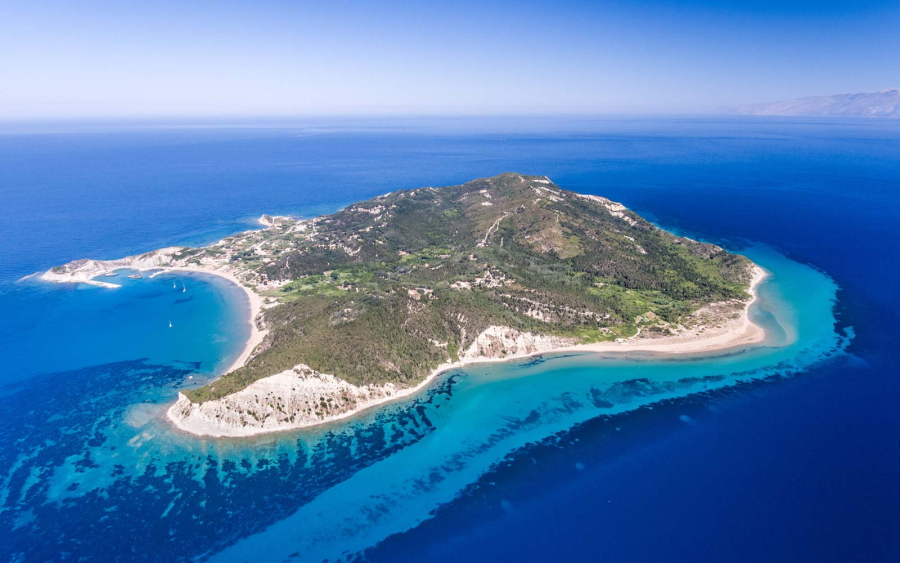- HOME
- Ionian Islands
- Corfu
- Southern Corfu Beaches and Villages
Southern Corfu
Beaches and Villages
This guide to southern Corfu’s beaches and villages includes busy resorts, quiet beach, hill villages and the southernmost tip of Corfu at Cape Asprókavos.
Pérama
Pérama is an often overlooked little resort, the first one you reach heading south from Corfu Town, on the far side of the Chalkiopoúlou lagoon from the airport. The fact that it does get some airport noise, depending on the wind direction, means it's not proved popular with the overseas package tour operators. You also have to climb down some steep steps to the beaches, which is not so bad, though the climb back at the end of the day puts many people off.
If you're not an avid beach person, though, the village can make a handy base, with several good restaurants, easy access to Corfu Town, the east coast and to the Achilleion Palace and the village of Gastoúri around it. It also remains very Greek and has not taken on an international face as most other resorts have.
Sinarádes
This large, attractive hill town is a friendly place where the older locals greet you and seem pleased you’ve paid a visit. Its main attraction is the History and Folklore Museum of Central Corfu which, though small, is one of the most delightful museums on the island, set in a traditional Corfu house on a quiet back street.
This file is licensed under the Creative Commons Attribution 3.0 Unported license.
Worn steps lead to the first floor, which contains a replica kitchen, dining room and bedroom of 1860-1960. On the second floor is a fascinating array of items including musical instruments, toys, traditional costumes, shadow theatre, weaving loom, corn mill, shoemaker’s workbench, and a stuffed caretta turtle.
The star exhibit is a Papyrella, a boat made of reeds like those of ancient Egypt and used on the island’s west coast until World War II. Some 450 items are on display, many donated by the people of Sinarádes and nearby villages.
Ágios Górdis
Though comparatively small, Ágios Górdis has become a brash and busy resort which is not for those who like the quiet side of Greek life. Plenty of people do enjoy what it's got to offer, and this includes one of the best beaches on the island, a curving bay of soft sand backed by wooded hills.
This file is licensed under the Creative Commons Attribution 3.0 Unported license.
Much of the entertainment centres on the Pink Palace, which is a hotel/hostel that's as flamboyant as the name suggests. It houses swimming pools, bars, restaurants, shops, sports facilities and a disco, all open to non-residents.
Worth noting if you're just visiting for the day to sample the beach is that parking by the beach is very limited indeed, and the narrow roads can get jammed with traffic, so look for the car park sign further up the hill before you start descending to the beach and leave your car there.
Some Cool Corfu Souvenirs
Áyii Déka
Corfu's second highest mountain is Áyii Déka, which stands 576 meters (1,889 feet) high, to the south of Corfu Town. There is a gorgeous view back towards Corfu Town from the village of Áyii Déka, which is reason alone to warrant a visit.
If you don't have the freedom of a car, many coach tours take a stop here to both take in the view and relax in a typical hill village. The name, incidentally, means 'Ten Saints', and there is an exhilarating climb to the top of the mountain from the village of Áno Garoúna.
Paramónas
One of the nicest resorts on this stretch of the west coast, although it hardly merits being called a resort – more of a village with a beach, a few tavernas, and several places to stay. No buses go here and the narrow road to it from the nearest town, Ágios Mattaíos, zig-zags and forks several times so casual visitors may or may not end up there.
Those who do get there, find a pleasant beach, somewhere good to have lunch or an evening meal, a hotel to stay the night if you wish... and not much else. For many people, that's all they need.
Ágios Mattaíos
This is the only town of any size in this part of central Corfu, though if you blink you could miss it. Blinking while driving through isn't recommended, however, due to the narrow streets and blind corners which all through traffic has to negotiate. Drivers have to simply hope that a huge bus or tractor isn't coming the other way.
It has a cluster of shops and cafés, and very much a rural feel, hardly impinged upon by the tourism along the coast. It stands on the slopes of the mountain of the same name, which at 463 meters (1,519 feet) offers a good hike from a path within the village, and at the end some impressive views of the valley inland and the coast to the west.
Moraïtika
First impressions of Moraïtika might not be favourable, as it appears to be a long stretch of bars, shops, and restaurants along a busy main road, but it has managed to retain some character and it attracts a broad cross-section of people.
As with many of the resorts, away from the beach there's an old part of town, in this case Áno Moraïtika, which nestles on the slopes of the hill towards the north of the modern town centre. Here there's some peace in among the old houses and the relaxed cafés and tavernas, where the locals hang out.
You won't find much peace on the main street of modern Moraïtika in the evening, when the bars and clubs burst into life, but as yet it has not become an over-the-top party place like Kávos, further south. During the day the activity focuses on the long beach, which might not be as pretty as some on the west coast but makes up for it with plenty of activities.
Mesongí
Mesongí is separated from Moraïtika only by the Messongís River, which is surprisingly wide in winter and spring after the rains. It makes rather an attractive boundary, too, and although the two resorts do merge into one, there is a definite change of feel as you head south into Mesongí.
It is quieter and more laid-back than its 'big brother', with more of a family and a Greek feel to it. The beach isn't as large or as good as the one across the river, but if you don't mind that and want somewhere that's a little quieter then the narrow streets of little Mesongí could be it. And south of here the coast gets quieter still.
Gardíki Castle
The road south from Paramónas and the one north from Lake Korissión meet at Gardíki Castle, though don't expect a towering ruin as Gardíki is an odd castle in that it is almost at ground level. The Byzantine fortress is thought to date back to the start of the 13th century and for a long time was closed to the public but now is open again... not that there's very much to see.
This file is licensed under the Creative Commons Attribution 3.0 Unported license.
A walk up to the highest point, which is a small mound, gives an overall view of the defensive walls. You also get a view of the land around, which gives an idea of how flat this particular part is, but there is not a lot else for the casual visitor: big green lizards and wild flowers mainly.
A short walk along the road towards Paramónas, on your right, is a path which leads up to a cave where Paleolithic remains have been found and which can be seen in the Archaeological Museum in Corfu Town.
Boúkaris
Boúkaris is one of the most delightful spots on the whole of the east coast. It's a world away from the bustle of the resorts north of Corfu Town, as this is the world of the deserted beach, the fish taverna by the sea, and low-key tourist development. It’s a place for walkers, and those seeking to find the traditional way of life of Corfu, before fishing villages like this were swallowed up by the needs of the modern holidaymaker.
The coast road south from here becomes rather too rough for the average car, and nervous drivers should take the inland road if they want to head further south. Boúkaris, though, is the kind of place you may never want to leave, once you've found it.
Petríti
If Petríti had a good beach then it would no doubt be a popular tourist spot by now, as it's a pleasant village that spreads out from a large harbour into an open plain and up the slopes of green hills. It has a big, open feel to it, and a friendly air, perhaps caused by the fact that it isn't a busy tourist resort.
The harbour for such a small place is surprisingly large, with some big commercial fishing boats going in and out, as well as the smaller family boats off to catch fish for the island's markets and tavernas. If touring this part of the island, it’s definitely worth a visit.
Ágios Geórgios
At the southern end of Lake Korissión, the lovely sandy dunes become the lovely sandy beach of the small resort of Ágios Geórgios. Small but growing, as there’s now quite a bit of tourist development here and plenty of watersports on the beach to keep everyone occupied.
It's a place that's popular with families, as there are plenty of children's activities too, and though there's not much of a Greek feel to the place, it's still an enjoyable relaxed resort in a pretty setting.
Ayía Varvára
If you want somewhere quiet but still with a bit of life to it, then Ayía Varvára, hidden away at the end of a side road in the south of the island, could be just the spot. It has an attractive sandy beach, a few tavernas and rooms, and inland on a hill sits the old village where life goes on as it has for centuries at its own slow pace. There are good walks to be had, and it's the perfect place for chilling out for a few days and getting totally relaxed.
Lefkímmi
There are few if any conventional tourist attractions in Lefkímmi – no museums, no beach, no seafront tavernas – and since the building of a bypass which takes traffic right to Lefkímmi port for the ferries, there is probably no reason for visitors to go there at all. This is a shame, as it's because of these very reasons that people should try to pay a visit.
This file is licensed under the Creative Commons Attribution-Share Alike 4.0 International license.
It is the main town of southern Corfu, the second largest on the island after the capital, and very much a rural community. It’s a rare chance to see a sizeable Corfu town that is virtually untouched by tourism. Lefkímmi is made up of several little villages that have all grown together, and negotiating the one-way system that winds through them can be daunting for the driver. The best solution is to find somewhere to park as soon as you can, and get out and walk.
There is a bustling community here, shops that sell everything apart from souvenirs, tavernas where you can get a real Greek meal, and several large and interesting churches: you can't mistake the Church of St Arseniou, with its twin belfries.
Kávos
People tend to love Kávos or hate it. Those that love it will be staying there, and those that hate it probably won't go within miles of the place, though perhaps some are drawn by curiosity. It’s the undoubted party capital of Corfu, by a long way, but is tucked away at the far south of the island where it can be left to its own devices and not affect the lives of most Corfiots.
This file is licensed under the Creative Commons Attribution 2.0 Generic license.
When most of the rest of the island is sleeping, Kávos is booming to the beat of disco music, its streets filled with mostly European youth in various states of dress and inebriation. Along the main streets and down by the beach, clubs and bars with brash names all compete for custom, staying open until dawn. It winds down a little during the day, of course, when clubbers crash out on the very good sandy beach – one of the reasons for the resort's initial development.
Cape Asprókavos
About thirty minutes’ walk south of Kávos, and a world away in atmosphere, is the southern tip of Corfu: Cape Asprókavos. It's the recommended starting point for the Corfu Trail and to get to it you take the southern road out of Kávos, marked for Sparterá, and follow the signs for the path to the Cape.
It's a lovely walk through farmland, a breath of air after the non-stop nature of Kávos itself. The path leads to the Cape's cliffs, from where you can see Paxos across the sea to the south, and if you continue on around the headland you come to the ruins of an old monastery, which stands quietly retaining its monastic peace and solitude.
Latest Posts
-
The Lesser-Known Traditions of Greek Easter
Step off the beaten path this spring and discover the enchanting — and often surprising — Easter traditions found across Greece. -
Easter in the Mystical Castle of Monemvasia
In the castle town of Monemvasia, with its dramatic medieval backdrop and sea views, Easter is a deeply spiritual and atmospheric experience. -
Sifnos: Greece’s Hidden Culinary Star on the Rise
Sifnos, a Cycladic island, is gaining fame for its rich culinary heritage, especially the beloved melopita honey-cheese tart. -
Easter in Leonidio: A Tapestry of Light, Culture and Cliffs
In Leonidio, Easter comes alive with handmade hot air balloons in the sky and lanterns made from bitter oranges in the streets. -
April 9 Strike in Greece to Impact Public Transport, Ferries and Air Travel
Transportation and travel across Greece will face disruptions on Wednesday, April 9, as public transport, ferry and aviation workers join a nationwide strike called by Greek labor unions. -
Ancient Theater of Lefkada Brought Fully to Light Following Systematic Excavation
The Greek Culture Ministry has announced that the first ancient theater ever identified in the Ionian Islands has recently been brought fully to light on Lefkada, revealing an impressive monument that… -
Seven Greek Traditions Recognized as Intangible Cultural Heritage
From traditional barrel-making to age-old folk dances, seven new entries on Greece’s National Inventory preserve the country’s living heritage for future generations. -
Greek Air Traffic Controllers to Hold 24-hour Strike, Disrupting Flights on April 9
The Hellenic Air Traffic Controllers Union have announced a 24-hour strike for Wednesday, April 9, in response to the protest called by the Civil Servants’ Confederation (ADEDY). The strike is being h… -
Ten Best Budget Hotels on Santorini
Greece Travel Secrets picks the ten best budget hotels on Santorini, some with caldera views, some near beaches and some close to the heart of Fira. -
No Ferries in Greece on April 9 as Seamen Join Nationwide Strike
The Pan-Hellenic Seamen’s Federation (PNO) has announced its participation in the 24-hour strike called by the General Confederation of Greek Labor (GSEE) on Wednesday, April 9. The strike, which will…
